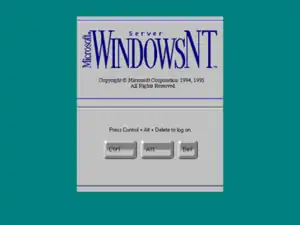 Cairo Server login screen, based on Windows NT 4.0 Server (1175.1) | |
| Developer | Microsoft |
|---|---|
| Working state | Discontinued |
| Released to manufacturing | Cancelled |
| Official website | www |
Cairo was the codename for a project at Microsoft from 1991 to 1996. Its charter was to build technologies for a next-generation operating system that would fulfill Bill Gates's vision of "information at your fingertips."[1] Cairo never shipped, although portions of its technologies have since appeared in other products.
Overview
Cairo was announced at the 1991 Microsoft Professional Developers Conference by Jim Allchin.[2] It was demonstrated publicly (including a demo system for all attendees to use) at the 1993 Cairo/Win95 PDC.[3] Microsoft changed stance on Cairo several times, sometimes calling it a product, other times referring to it as a collection of technologies.[4]
Features
Cairo used distributed computing concepts to make information available quickly and seamlessly across a worldwide network of computers.
The Windows 95 user interface was based on the initial design work that was done on the Cairo user interface.[5][6] DCE/RPC shipped in Windows NT 3.1. Content Indexing is now a part of Internet Information Server and Windows Desktop Search.[2]
The remaining component is the object file system. It was once planned to be implemented in the form of WinFS as part of Windows Vista but development was cancelled in June 2006, with some of its technologies merged into other Microsoft products such as Microsoft SQL Server 2008, also known under the codename "Katmai".[7]
See also
References
- ↑ Bill Gates (1994-11-14). "Information At Your Fingertips, 1994 Comdex Keynote". Archived from the original on 2007-11-10. Retrieved 2008-01-02.
- 1 2 Larry Osterman (2004-10-15). "So what exactly IS COM anyway?". Larry Osterman's WebLog. Retrieved 2023-02-02.
- ↑ Jon Udell (2005-09-07). "WinFS and social information management". InfoWorld. Archived from the original on 2006-01-09. Retrieved 2007-01-07.
- ↑ Jon Udell (November 1996). "The next version of Windows NT will flex its enterprise muscle by incorporating features from "Cairo."". Byte. Archived from the original on 2007-02-25. Retrieved 2007-01-07.
- ↑ Kent Sullivan (April 17, 1996). "The Windows 95 User Interface: A Case Study in Usability Engineering". CHI 96 Design Briefs. Archived from the original on October 6, 2018. Retrieved 2008-10-22.
- ↑ "Microsoft Windows 95: Desktop Operating System Strategy". Directions on Microsoft. January 1995. Retrieved 2007-01-07.
- ↑ Quentin Clark (June 23, 2006). "WinFS Update". What's in Store. MSDN Blogs. Retrieved 2023-02-02.
- Notes
- Alan Deutschman (1992-12-28). "BILL GATES' NEXT CHALLENGE His aim: to lead the information revolution of the 1990s. That will land Microsoft, already the envy of its rivals, in a vast new competitive free-for-all". Fortune. Retrieved 2006-01-07.
- Nicholas Petreley (2002-04-08). "The Road to Cairo". Computerworld. Archived from the original on 20 May 2009. Retrieved 2007-01-06.
- Andrew Orlowski (2006-06-19). "Microsoft's Cairo reborn as killer eye-candy". The Register. Retrieved 2007-01-06.
- Microsoft (1993-03-08). "Microsoft Windows Cairo Product Planning" (PDF). Microsoft. Retrieved 2007-01-06.